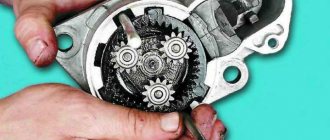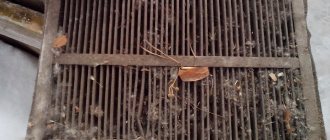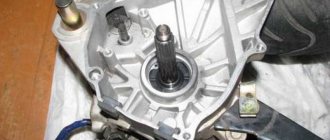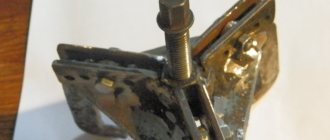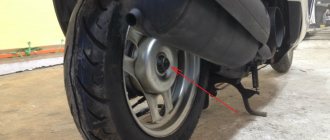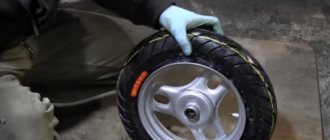Cars sedan, hatchback 1.4, 1.6 l 2011, 2012, 2014, 2015 produced
Where are the fuses and relays located for the Hyundai Solaris?
In the mounting block of the engine compartment - number 11
To get to the fuses, you need to press the latches and open the cover
On the inside of the cover of the fuse and relay mounting block there is a diagram of the arrangement of the elements.
Inside the mounting block there are tweezers for removing fuses.
The main fuse is installed on the side wall of the mounting block.
Replacement of fuses is done with tweezers, the relay is changed by hand.
The fusible links in the main fuse located on the side wall of the mounting block have this arrangement.
| Fusible link number | Current strength, A | Protected circuit |
| 1 | 50 | Tail light relay |
| 2 | — | Reserve |
| 3 | — | Reserve |
| 4 | 125 | Generator |
| 5 | 40 | Hydroelectronic ABS module, diagnostic connector |
| 6 | 40 | Hydroelectronic ABS module |
| 7 | 40 | Heated rear window relay |
| 8 | 40 | Fan relay hyundai solaris |
| 9 | — | Reserve |
The Hyundai solaris mounting block itself is under the hood with the lid open.
Decoding
| Fuse, fuse and relay number | Current strength, A | Color | Purpose |
| 1 | — | — | Reserve |
| 2 | — | — | Reserve |
| 3 | 15 | Blue | Fuel module |
| 4 | 10 | Red | Hyundai solaris horn |
| 5 | 50 | Red | Power windows, hazard warning switch, central locking |
| 6 | 40 | Blue | Heating system control unit |
| 7 | 30 | Red | Electronic engine control unit |
| 8 | 40 | Blue | Ignition switch, engine start and stop button |
| 9 | 50 | Red | Ignition switch, engine start and stop button |
| 10 | 10 | Red | Air conditioner |
| 11 | — | — | Reserve |
| 12 | — | — | Reserve |
| 13 | 15 | Blue | Supply system |
| 14 | 10 | Red | Camshaft Position Sensor, Oxygen Concentration Sensor |
| 15 | 10 | Red | Electronic engine control unit |
| 16 | — | — | Reserve |
| 17 | 10 | Red | Instrument cluster, tail lights |
| 18 | — | — | Reserve |
| R1 | — | — | Reserve |
| R2 | — | — | Hyundai solaris horn relay |
| R3 | — | — | Ignition switch relay, engine start and stop buttons |
| R4 | — | — | Air conditioner relay |
| R5 | — | — | Ignition interlock switch relay |
| R6 | — | — | Fan Relay (Low Speed) |
| R7 | — | — | Fan Relay (High Speed) |
| R8 | — | — | Diagnostic connector relay |
| R9 | — | — | Hyundai solaris ignition switch relay |
| R10 | — | — | Ignition switch relay, engine start and stop buttons |
| R11 | — | — | Emergency Brake Warning Relay |
| R12 | — | — | Engine control unit relay |
| R13 | — | — | Fuel pump relay |
| R14 | — | — | Reserve |
| R15 | — | — | Radiator fan relay |
Fuses in the mounting block in the Hyundai Solaris interior.
Located in the instrument panel. To get there, you need to pry the recess in the decorative cover with your fingers and, overcoming the force of the latches, remove it.
Decoding
| Number | Current strength, A | Name | Color | Protected circuit |
| 1 | 15 | FRT Deicer | Blue | Heated windshield |
| 2 | 15 | P/QUTLET | Blue | Socket for connecting additional equipment |
| 3 | 15 | C/UGHTER | Blue | Cigarette lighter fuse hyundai solaris |
| 4 | 10 | ACC | Red | Egnition lock |
| 5 | 10 | A/BAG IND | Red | Front airbag deactivation warning light |
| 6 | 10 | D/BAG | Red | Airbag hyundai solaris |
| 7 | 10 | T/SIG | Red | Hazard switch |
| 8 | — | — | — | Reserve |
| 9 | — | — | — | Reserve |
| 10 | 15 | R/WPR | Blue | Windshield wiper and washer switch lever |
| 11 | — | — | — | Reserve |
| 12 | 10 | R.R. | Red | 'Rear fog light |
| 13 | 10 | FRT | Red | Front fog lights |
| 14 | 10 | ROOM 2 | Red | Battery Saver Relay* |
| 15 | 15 | STOP LP | Blue | Brake lights |
| 16 | 10 | CLUSTER | Red | Instrument cluster hyundai solaris |
| 17 | 10 | IG1 1 | Red | Security control module |
| 18 | 10 | ABS | Red | Hydroelectronic anti-lock braking system module |
| 19 | 10 | B/UP LP | Red | Reversing light switch |
| 20 | 10 | PCU | Red | Immobilizer |
| 21 | 10 | H/LP LFI | Red | Left headlight |
| 22 | 10 | DAYTIME RUNNING LIGHT | Red | Daytime Running Lights |
| 23 | 15 | HAZARD | Blue Grey | Hazard switch |
| 24 | 25 | SMKJ | Electronic key control module | |
| 25 | — | Reserve | ||
| 26 | 10 | SMK2 | Red | Engine start/stop button |
| 27 | 15 | TCU | Blue | Vehicle speed sensor |
| 28 | 15 | IGN COIL | Blue | Ignition coils |
| 29 | 10 | IGN 2 | Red | Power windows, sunroof |
| 30 | 25 | F/WPR | Grey | Windshield wiper |
| 31 | 20 | DOOR LOCK | Yellow | Door lock control unit |
| 32 | 25 | SAFETY P/WDW | Grey | Locking power windows |
| 33 | 15 | S/HEATER | Blue | Electrically heated front seats Hyundai Solaris |
| 34 | — | — | — | Reserve |
| 35 | 10 | ROOM 1 | Red | Interior lighting, air conditioning |
| 36 | 20 | AUDIO | Yellow | Audio system |
| 37 | 10 | TAIL LFI | Red | Rear left lamp, license plate lamps, left headlight |
| 38 | 10 | TAIL Rl-I | Red | Right tail light, right headlight |
| 39 | 10 | START | Red | Starter relay, anti-theft alarm |
| 40 | 10 | H/LP RH | Red | Right block headlight |
| 41 | 25 | P/WDW LH | Grey | Power window control unit, left rear power window switch |
| 42 | 25 | P/WDW RH | Grey | Power window control unit, right rear power window switch |
| 43 | 10 | HTD MIRR | Red | Heated exterior mirrors |
| 44 | 10 | A/CON_2 | Red | Air conditioner hyundai solaris |
| 45 | — | — | — | Reserve |
How to remove the main fuse
Unscrew the two nuts and remove the wire ends from the studs of the mounting block
Use a screwdriver to pry and remove the main fuse
Removing and installing the mounting block in the Hyundai solaris interior
Disconnect the wire from the negative terminal of the battery
Remove the lower trim of the instrument panel
Fold out the fixing bracket
Disconnect the wiring harness block from the mounting block. Similarly, disconnect the upper block of the wiring harness.
Press the latch and disconnect the side block of the wiring harness
Using a screwdriver, pry and remove the diagnostic connector from the mounting block mounting bracket
Press the fastening clamp and disconnect the relay from the right wall of the mounting block.
Similarly, disconnect the lower
and the upper block of wiring harnesses from the left wall of the mounting block
Unscrew the two nuts securing the mounting block
Move the mounting block aside and disconnect the three rear wiring harness connectors.
Remove the fuse mounting block
Where is the diagnostic connector for Hyundai Solaris?
It is located inside the car in the instrument panel, near the fuse box.
Tags: Hyundai fuse box
Layout diagram
The Hyundai Solaris has two fuse blocks. One of them is located directly in the cabin. There are those fuses that can quickly lose their functionality. Accordingly, in the event of a breakdown, you will not need to climb under the hood of the car. To gain access to the block, simply remove the decorative trim using a screwdriver.
The second block is located directly under the hood. It is located on the right side of it. The block is protected by a plastic cover, which can also be removed using a screwdriver. Like any other element, it can become unusable, so it is important to know the location of each of the fuses.
The diagnostic connector is located inside the car. You can find it right in the instrument panel, next to the fuse box. To correctly select and replace fuses, you can rely on special diagrams. The original diagram can always be found on the lid. If it was replaced, you will have to use a schematic representation of the arrangement of elements proposed below.
Why the cigarette lighter does not work on the Hyundai Solaris: reasons
Cigarette lighters in modern cars are needed not only for their intended purpose.
The presence of various gadgets, for example, requires additional power sources for recharging. This need can be satisfied by just such a device available on the Hyundai Solaris. Video
The video will tell you how to quickly and correctly, and most importantly, carry out repairs yourself
Since one socket is not enough, you have to experiment with splitters, adapters, and sophisticated devices. Which sometimes leads to device failure, just when it is so needed. If someone has not used this attribute at all before, they may encounter it malfunctioning at the most inopportune moment.
Replacing fuses yourself
If one of the fuses has done its job and has blown, it is advisable to replace it as quickly as possible. Otherwise, you will not have protection against short circuits, and another vehicle system may fail.
It is strictly forbidden to remove a burnt-out fuse by hand. We recommend that you use tweezers, which are located in the same block. Dismantling of parts is carried out only with the help of it, otherwise there is a risk of damaging the fuses.
The plastic decorative trim is pryed off with a screwdriver so as not to damage it. Do not touch it with your fingers or apply force to ensure that the plastic clips remain fully functional. If the cover is original, it will definitely show a detailed diagram of the fuses.
Use only original jumpers. Don't use items you made yourself. Otherwise, there is a risk of damaging the devices or even causing a fire in the car.
Repairing the wiring supplying the cigarette lighter
In order to carry out this procedure, you need to go to a service station or find a suitable electrician. You won't be able to deal with this on your own. The only nuance that you can solve yourself is to check the presence of power at the terminals and open connections available for testing. You will need some equipment:
- tester;
- voltmeter;
- multimeter
Having even a little knowledge in the field of physics or electrical engineering at the school level, you can conduct a superficial diagnosis of the electrical component of the system. If all the wiring turns out to be in perfect order, then the third and only problem needs to be solved.
Removing and installing the mounting block
If the problem lies in the mounting block, then you need to replace it too:
- Disconnect the connected wire from the negative terminal of the battery.
- We remove the lower trim of the dashboard to gain access to the elements.
- We bend the fixing bracket. Disconnect the wiring harness block from the mounting block. Then we get rid of the top block of the harness.
- To disconnect the side block of the wiring harness, press its lock.
- Using a screwdriver, remove the diagnostic connector from the bracket securing the mounting block.
- We disconnect the relay from the right wall of the mounting block by pressing the fastening latch. We also disconnect the upper and lower blocks from the left wall.
- We unscrew the two nuts securing the mounting block.
- To disconnect the three rear blocks of the wiring harnesses, move the mounting block to the side.
- Remove the mounting block.
This completes the procedure. All that remains is to install the new part and check whether the mechanism works correctly.
Subtleties of preparation for work
To set up an effective system, you need to start by selecting a suitable kit, taking into account the design features of the cabin.
Popular embedded systems options:
- Installation kits from German manufacturers are the most expensive, but also the most reliable and productive. Almost every complex is equipped with overheating protection. Weaco kits also provide different operating modes.
- The Russian-made Emelya kit is slightly cheaper, but also has decent characteristics. The heating element here is made of carbon fiber or in the form of reinforced cable.
- Chinese versions are the most affordable, but you should not connect them due to their low reliability. Uneven heating, problems with the power button, and possible short circuits are common, which is typical for Autoline versions.
When choosing the appropriate option, you can also consider products from Taiwan – the Megalight kit. But for VAZ cars it is better to choose the Emelya system. To properly equip seat heating with your own hands, you need to select tools and materials.
What you will need for work:
- screwdrivers and wrenches for removing seats;
- clamps (if necessary), marker;
- scissors, knife, pliers;
- soldering iron, electrical tape, multimeter;
- If the purchased kit does not contain double-sided tape, you need to buy it separately or use glue 88.
Important:
Before you start installing the system, you should check the package contents. Sometimes you need to additionally purchase wires, a fuse connector, and adhesive.
Hyundai Solaris 2 - fuses and relays
Hyundai Solaris 2nd generation was produced in 2017, 2022, 2022, 2022, 2022, 2022 mainly with 1.4 and 1.6 liter gasoline engines. During this time, the model underwent restyling. In this material you will find a description of fuses and relays of the 2nd generation Hyundai Solaris with block diagrams and their locations. Separately, we note the cigarette lighter fuse.
The number of elements in blocks may differ from those presented and depends on the level of equipment and year of manufacture. Check the diagrams with your technical documentation.
Why do you need heated seats?
Having a similar function in a car is very necessary during periods of severe frost. Getting into a car that has been parked for a long time in the cold is unpleasant and unsafe for the health of the driver and passengers.
Overheating of seats also poses a danger to human health and to the car.
There are many articles on the Internet about the benefits and harms of heating. Let's dot all the i's. Driving for a long time with the heater on can have a bad effect on ladies and guys. Accordingly, it is recommended to use this option consciously in order to protect yourself from cystitis or prostatitis.
General rules for using heating:
- Do not allow the seats to become significantly overheated.
- When it's cool, turn on the heating and don't sit on them for a while.
- Once the seats have been warmed up, turn off the system. Next, heat the interior with a stove.
- You cannot stay in the salon in warm clothes for a long time.
Following these rules will help you protect yourself from overheating and not harm yourself.
Replacement
seat heating fuse
It was difficult to figure out where he was.
Hyundai Solaris 1 fuses and relays
Hyundai Solaris 1st generation was introduced in 2010. It was produced in 2011, 2012, 2013, 2014, 2015, 2016 and 2017 with sedan and hatchback bodies, mainly with 1.6 and 1.8 liter petrol engines. During this time, Solaris underwent restyling. In this material you will find a description of the fuses and relays of the Hyundai Solaris 1 with block diagrams, photos - examples of execution and locations. Note the fuse responsible for the cigarette lighter.
p, blockquote 1,0,0,0,0 —>
p, blockquote 2,0,0,0,0 —>
The purpose of fuses and relays in Hyundai Solaris 1 units may differ from those presented and depend on the level of equipment and year of manufacture. Check the purpose with the diagrams on the back of the protective cover.
Fuses for Hyundai Solaris 2022, 2022, 2019.
Where are the fuses and relays located in the Hyundai Solaris 2 (from 2022).
The fuses and relays are located in the passenger compartment (driver's side), you need to remove the cover, as shown in the diagram, on the back there will be a designation of the fuses.
| Fuse no. | Fuse name | Fuse rating | Protected circuit |
| F1 | STOP LAMP | 15 A | Electronic brake light unit (instrument panel junction box) |
| F2 | SMART KEY | 25 A | Smart Key system control unit (electronic key, keyless entry) |
| F3 | SPARE1 | 10 A | Spare |
| F4 | E-CALL | 10 A | E-Call block (emergency call block) |
| F5 | TURN LAMP | 15 A | BCM (Body Control Module), SLM (Seat Belt Reminder and Lighting Module) |
| F6 | FRT FOG | 15 A | Front Fog Light Relay (Dashboard Junction Box) |
| F7 | A/CON2 | 10 A | Air conditioner control unit |
| F8 | P/OUTLET2 | 20 A | Power socket (cigarette lighter) No. 1 (cigarette lighter fuse Solaris 2) |
| F9 | P/OUTLET3 | 20 A | Power socket (cigarette lighter) No. 2 (cigarette lighter fuse Solaris 2) |
| F10 | ACC | 10 A | Rear power socket (cigarette lighter) relay (instrument panel junction box), door mirror adjustment switch |
| E-Call unit, BCM, SLM unit, audio system (radio), multimedia navigation system | |||
| Smart Key system control unit (electronic key, keyless entry) | |||
| F11 | S/ROOF | 15 A | Hatch (top hatch electric motor) |
| F12 | IMMO | 10 A | Immobilizer module |
| F13 | SPARE2 | 15 A | Spare |
| F14 | WIPER | 25 A | Multifunction (steering column) switch, wiper motor, engine compartment junction box (Relay 6) |
| F15 | RR FOG | 10 A | Rear Fog Light Relay (Dashboard Junction Box) |
| F16 | DRL | 10 A | DRL (Daytime Running Light) Relay (Dashboard Junction Box) |
| F17 | MODULE6 | 10 A | Power Window Relay (without BCM) (Instrument Panel Junction Box), Heated Windshield Washer Nozzles |
| Driver/front passenger seat heating control unit | |||
| Rear seat heating control unit | |||
| Defroster Relays 1 and 2 (Front Defroster Junction Box), Sunroof Motor | |||
| F18 | WASHER | 15 A | Steering column switch (washer) |
| F19 | MODULE7 | 10 A | BCM (Body Control Module) |
| F20 | 10 A | Interior light auto-off relay (instrument panel fuse box, version with auto-off relay) | |
| Navigation lamps (roof light) (without auto-off relay), interior lighting (ceiling light) (without auto-off relay), luggage compartment light | |||
| Instrument cluster (instrument cluster), OBD diagnostic connector, BCM, SLM unit, air conditioning control unit | |||
| F21 | AUDIO | 20 A | Head unit of an audio system or multimedia navigation system (radio, GU) |
| F22 | DR LOCK | 20 A | Door unlock relay, Door lock relay, Trunk release relay (central locking) |
| F23 | BRAKE SWITCH | 10 A | Smart Key system control unit (electronic key, keyless entry), brake light switch (limit switch) |
| F24 | RR HTD | 10 A | Driver's side power outside mirror, air conditioning control unit |
| Passenger side power outside mirror | |||
| F25 | MODULE5 | 10 A | SLM unit, BCM, Smart Key system control unit (electronic key, keyless entry) |
| F26 | A/CON1 | 7.5 A | A/C Fan, Engine Junction Box (Relay 2), A/C Control Module |
| F27 | ENG T | 15 A | Automatic transmission selector lever position indicator (automatic transmission): Sport mode switch, transmission mode switch, brake light switch |
| Manual Transmission: Engine Compartment Relay and Fuse Box, Brake Light Switch | |||
| F28 | TAIL RH | 7.5 A | Right headlight, audio system (radio, power steering), instrument panel switch, heated steering wheel, instrument cluster (instrument panel) |
| Head unit of multimedia navigation system (radio, GU), AUX/USB socket, automatic transmission selector lever position indicator | |||
| Main power window switch, front passenger power window switch | |||
| Rear power window switches, center panel switch, air conditioning control unit | |||
| Rear right combination light (in/out) | |||
| F29 | ABS3 | 10 A | ABS control unit (abs, anti-lock braking system), ESP control unit (dynamic stabilization system) |
| F30 | MODULE3 | 10 A | Switch on the left side of the front panel, BCM |
| F31 | NTO STRG | 15 A | Heated steering wheel |
| F32 | FRT S/HTR | 20 A | Driver/front passenger seat heating control unit |
| F33 | SAFETY WDW | 25 A | Driver's door power window assembly with anti-pinch protection |
| F34 | RR S/FITR | 20 A | Rear seat heating control unit |
| F35 | TAIL LH | 7.5 A | Left rear combination light (in/out), left/right license plate light, left headlight |
| F36 | SPARE3 | 10 A | Spare |
| F37 | MODULE2 | 10 A | Air conditioning control unit, left/right headlights, head unit of audio system or multimedia navigation system (radio, power steering) |
| Control unit for heated driver/front passenger seats, heated steering wheel, E-Call unit | |||
| Control unit for heated rear seats, automatic transmission selector lever position (sport mode switch) | |||
| F38 | MODULE1 | 10 A | BCM (Body Control Module), SLM (Seat Belt Reminder and Lighting Module) |
| F39 | A/BAG | 10 A | SRS control unit (airbag system) |
| F40 | P/WDW RH | 25 A | Main power window switch, front passenger power window switch |
| F41 | P/WDW LH | 25 A | Power window main switch |
| F42 | START | 10 A | Automatic transmission (automatic transmission): transmission mode switch (range switch) |
| Manual Transmission: ECM/PCM, Engine Compartment Junction Box (Relay 1), Smart Key Control Module (Keyless Entry) | |||
| F43 | ENG E4 | 10 A | ECM/PCM, Immobilizer Module, Smart Key System Control Module (electronic key, keyless entry) |
| F44 | CLUSTER | 10 A | Instrument cluster |
| F45 | A/BAG IND | 7.5 A | Instrument cluster |
| F46 | MDPS1 | 7.5 A | MDPS unit (EUR control unit (electric power steering)) |
The fuses and relays are located under the hood (in the engine compartment), you need to remove the cover, as shown in the diagram, on the back of the cover there will be a fuse designation.
| Fuse no. | Fuse name | Fuse rating | Protected circuit |
| F1 | MDPS1 | 80 A | MDPS unit (EUR control unit (electric power steering)) |
| F2 | ALT | 125 A (G4LC) 150 A (G4FG) | Engine compartment junction box (fuse – F3, F4, F5, F6) |
| F3 | RR DEFOG | 40 A | Rear Window Defogger Relay (Dashboard Junction Box) |
| F4 | ABS1 | 40 A | ABS/ESP control unit (ABS/ESP, anti-lock braking system) |
| F5 | ABS2 | 40 A | ABS/ESP control unit (ABS/ESP, anti-lock braking system) |
| F6 | BLOWER | 40 A | Engine Compartment Junction Box (Relay 2 - A/C Fan Relay) |
| F7 | WIPER | 10 A | Wiper motor (wipers), multifunction switch (steering column switch), engine compartment junction box (Relay 6) |
| F8 | ENG S2 | 10 A | Oxygen Sensor (Upper), Oxygen Sensor (Lower), Engine Compartment Junction Box (Relay 4, Relay 9), Evaporative Purge Control Solenoid Valve, Variable Geometry Intake Solenoid Valve |
| F9 | ENG S1 | 10 A | Oil Control Valve No. 1 (Inlet/Outlet), Engine Compartment Junction Box (Relay 3, Relay 11) |
| F10 | — | — | — |
| F11 | ENG E2 | 15 A | ECM/PCM (engine/automatic transmission control unit (ECU)) |
| F12 | — | — | — |
| F13 | H/LP RH | 10 A | Headlight right |
| F14 | H/LP LH | 10 A | Left headlight |
| F15 | — | — | — |
| F16 | — | — | — |
| F17 | — | — | — |
| F18 | — | — | — |
| F19 | IGN COIL | 20 A | Ignition coils No. 1 - 4, capacitor |
| F20 | INJECTOR | 15 A | ECM/PCM (engine/automatic transmission control unit), injectors No. 1–4 |
| F21 | B/UP LP | 10 A | Reversing light switch |
| F22 | — | — | — |
| F23 | BATT1 | 40 A | Instrument panel junction box (fuse - F15, F16, F20, F21, F22, F23) |
| F24 | BATT2 | 50 A | Instrument panel junction box (fuse - F32, F33, F34, power window relay) |
| F25 | IG2 | 40 A | Ignition Switch, PDM Junction Block (IG2 Relay), Relay 1 |
| F26 | — | — | — |
| F27 | C/FAN | 40 A | Engine Radiator Cooling Fan, Engine Compartment Junction Box (Relay 4, Relay 9) |
| F28 | ENG E1 | 30 A | Main Relay, Engine Compartment Junction Box (Fuse - Relay 13) |
| F29 | — | — | — |
| F30 | B/Alarm | 10 A | Security Alarm Siren, Auxiliary Junction Box (Relay 15) |
| F31 | ENG T | 20 A | PCM (Engine Control Module, ECU) |
| F32 | LO/H LP | 20 A | Low beam headlights, engine compartment junction box (Relay  |
| F33 | HI/H LP | 20 A | High beam headlights, engine compartment junction box (Relay 7) |
| F34 | F/PUMP | 15 A | Fuel pump (fuel pump), engine compartment junction box (Relay 3) |
| F35 | HORN | 15 A | Horn (horn), engine compartment junction box (Relay 10) |
| F36 | ENG E3 | 15 A | ECM/PCM (engine/automatic transmission control unit (ECU)) |
| F37 | A/CON | 10 A | Air conditioning (climate control, air conditioning compressor electromagnetic clutch), engine compartment junction box (Relay 11) |
| F38 | — | — | — |
| F39 | BATT3 | 40 A | Dashboard junction box (fuse - F1, F5, F6, side light (lamp) relay) |
| F40 | IG1 | 30 A | Ignition switch, PDM relay box (IG1 relay, ACC relay) |
| F41 | P/OUTLET1 | 40 A | Cigarette Lighter, Socket, Dashboard Junction Box (Power Socket Relay) (Solaris 2 Cigarette Lighter Fuse) |
Relay location in the fuse box under the hood.
| Relay no. | Protected circuit |
| RLY.1 | Starter relay |
| RLY.2 | A/C Fan Relay |
| RLY.3 | Fuel pump relay |
| RLY.4 | Cooling Fan Relay #1 |
| RLY.5 | Windshield wiper relay (wipers) No. 2 |
| RLY.6 | Windshield wiper relay (wipers) No. 1 |
| RLY.7 | High beam relay |
| RLY.8 | Low beam relay |
| RLY.9 | Cooling Fan Relay #2 |
| RLY.10 | Horn (horn) relay |
| RLY.11 | Air conditioning relay (climate control, A/C) |
| RLY.13 | Main relay |
| RLY.15 | Security Alarm Siren Relay |
Front wiper blade heater fuse panel (additional fuse and relay box under hood).
| Fuse no. | Fuse name | Fuse rating | Protected circuit |
| F1 | FR HTD LH | 40 A | Heating (heating) windshield relay (left side) |
| F2 | FR HTD RH | 40 A | Heating (heating) windshield relay (right side) |
| F3 | FR HTD | 10 A | Switch on the front panel (windshield heating switch) |
| Relay no. | Protected circuit |
| RLY.1 | Heated windshield relay (left side) |
| RLY.2 | Heated windshield relay (right side) |
Replacing fuses located in the engine compartment
The replacement operation is carried out in the event of a failure of the fuse or relay located in the engine compartment block. The car owner will need a new part of the appropriate value, gloves and tweezers to remove it.
Work algorithm:
- disconnect the negative terminal from the battery, wait at least 10 minutes;
- release access to the block by squeezing two plastic latches;
- remove the black plastic cover of the unit;
- find the desired element by first determining its location on the diagram, and then finding it on the block. It will be possible to detect a burnt-out one by the melted jumper;
- carefully remove the part with tweezers;
- Insert a new one to replace the burnt one.
As standard, the block is equipped with fuses with short contacts, but if it was not possible to purchase one, it can be replaced with a more popular part with long contacts.
Larger fuses in the motor block may also fail; depending on their rating, they are blue or white. This element can be easily removed with your fingers – you just have to pull the plastic casing. A new one is also installed manually.
FAQ
Using our adapter you connect to the interior lamp. Consequently, power will be supplied and disconnected to the DVR or other device, just like to the lamp. All cars implement this differently. For some it is related to the ignition, for some it is related to the central locking. In some cars, power is constantly supplied to the lamp. But you can check how it will work on your car. To do this, turn on the courtesy light to the constant lighting position and watch its behavior when you turn on the ignition and close/open the car.
Connecting to a lampshade, of course, is not the official way to connect a DVR. Everything you do with your car is done at your own peril and risk. And, theoretically, the official dealer can use the fact of connection to deny you warranty electrical repairs. But a huge advantage of connecting with our adapter compared to other methods (twisting, soldering) is that you can very easily dismantle everything and return it to its original state before going to the OD.
We do not claim that connecting to a lampshade is the most correct and safe way to connect. We are only trying to help those who have chosen this method for themselves to do it easier, faster and perhaps somewhat more correctly, without twisting the solder, etc. In any case, everything you do with your car is done at your own peril and risk. Thousands of people use this method of connecting DVRs, radar detectors and other devices. Practice shows that this is a fairly safe and simple way to connect. But you still need to be careful. We do not recommend connecting more than one consumer in this way. This can cause an increase in load and melting of the vehicle's standard wiring.
You can place an order and pay for it in our online store. Payment is made by card using the Tinkoff payment system. We ship orders within three business days from payment. Delivery throughout Russia and the CIS countries is carried out by Russian Post using first class mail. Shipping costs are calculated automatically when placing an order. After sending your order, a letter with a tracking number will be sent to your email address (Letters sometimes end up in Spam).




